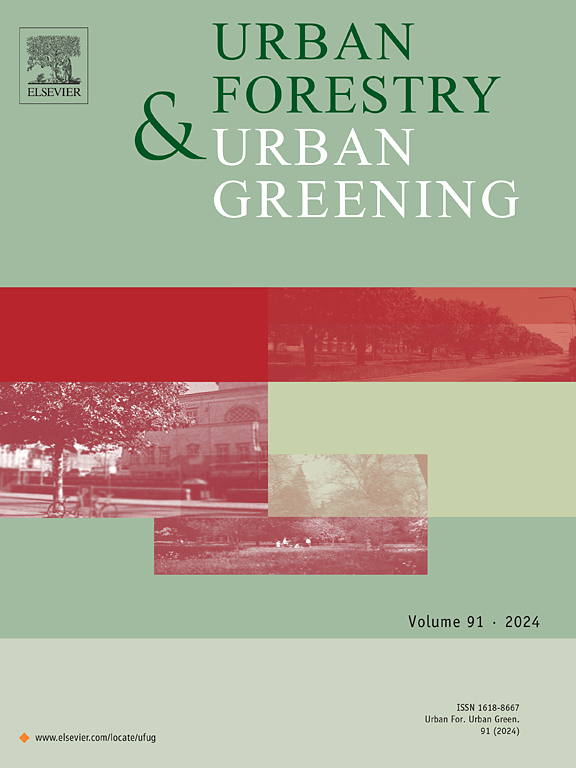城市边缘社会经济群体从使用绿地中获得更多的货币公平和健康福祉惠益
IF 6
2区 环境科学与生态学
Q1 ENVIRONMENTAL STUDIES
引用次数: 0
摘要
亲近自然对健康的益处众所周知,而且越来越多地被作为保护生物多样性的支持论据,尤其是在城市。然而,由于缺乏将效益、受益人数和货币价值联系起来的数据,从经济角度计算亲近自然所带来的效益具有挑战性。本研究使用手机 "ping "数据来估算世界第二大国家公园城市阿德莱德周边大型生物多样性绿地(如大都市国家公园)的使用情况。这些 "ping "数据与公园用户和普通人口数据相结合,计算出城市中不同社会经济群体的市民从使用绿地中获得的健康益处。然后,利用健康负担成本的其他数据,计算出 2018-19 年度 20 个大都市国家公园的 284.2503 万游客因亲近自然而减少的健康成本。在所有社会经济群体中,通过访问城市附近的生物多样性绿地,估计减少了价值 1.4 亿澳元的医疗成本。这相当于南澳大利亚州医疗保健预算总额的约 4%。重要的是,尽管进入国家公园需要支付额外的私人费用,但大都会地区社会经济地位相对最低的 40% 地区的市民因使用公共绿地而减少的医疗费用却高得不成比例。因此,这项研究为在城市和州范围内制定健康和生物多样性保护决策提供了机会。本文章由计算机程序翻译,如有差异,请以英文原文为准。
Increased monetary equity and health wellbeing benefits for marginal urban socioeconomic groups from access to green space
Health benefits from access to nature are well known and increasingly cited as a supporting argument for the conservation of biodiversity, particularly in cities. However, calculating the benefits from access to nature in economic terms is challenging due to a lack of data linking benefits, number of beneficiaries, and monetary values. This study used mobile phone ‘ping’ data to estimate the use of large biodiverse green spaces (e.g., metropolitan National Parks) surrounding Adelaide, the World’s second National Park City. This ping data was combined with park user and general population data to calculate a health benefit from access to green spaces for citizens across socio-economic groups in the city. Additional data on health burden costs was then used to calculate reduced health costs from access to nature in 20 metropolitan National Parks by 2,842,503 visitors in 2018–19. Across all socio-economic groups, an estimated AU$140 million worth of reduced healthcare costs was generated through access to biodiverse green spaces adjacent to the city. This is equivalent to around 4 % of the total South Australian healthcare budget. Importantly, citizens from the relatively lowest 40 % of socio-economic areas in the metropolitan area received a disproportionately high reduced health cost from access to public green space, despite the additional private cost of accessing National Parks. This study thus provides an opportunity to frame both health and biodiversity conservation decisions at a city and state scale.
求助全文
通过发布文献求助,成功后即可免费获取论文全文。
去求助
来源期刊

Urban Forestry & Urban Greening
FORESTRY-
CiteScore
11.70
自引率
12.50%
发文量
289
审稿时长
70 days
期刊介绍:
Urban Forestry and Urban Greening is a refereed, international journal aimed at presenting high-quality research with urban and peri-urban woody and non-woody vegetation and its use, planning, design, establishment and management as its main topics. Urban Forestry and Urban Greening concentrates on all tree-dominated (as joint together in the urban forest) as well as other green resources in and around urban areas, such as woodlands, public and private urban parks and gardens, urban nature areas, street tree and square plantations, botanical gardens and cemeteries.
The journal welcomes basic and applied research papers, as well as review papers and short communications. Contributions should focus on one or more of the following aspects:
-Form and functions of urban forests and other vegetation, including aspects of urban ecology.
-Policy-making, planning and design related to urban forests and other vegetation.
-Selection and establishment of tree resources and other vegetation for urban environments.
-Management of urban forests and other vegetation.
Original contributions of a high academic standard are invited from a wide range of disciplines and fields, including forestry, biology, horticulture, arboriculture, landscape ecology, pathology, soil science, hydrology, landscape architecture, landscape planning, urban planning and design, economics, sociology, environmental psychology, public health, and education.
 求助内容:
求助内容: 应助结果提醒方式:
应助结果提醒方式:


